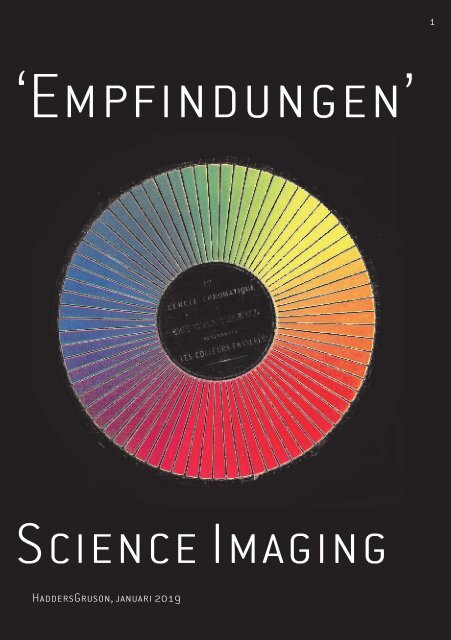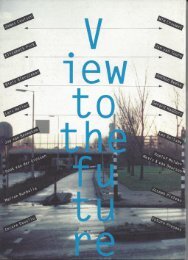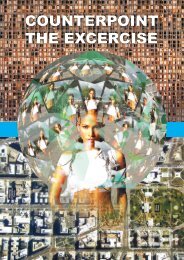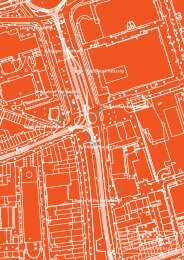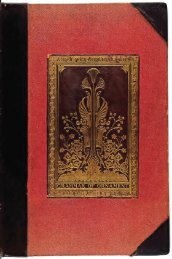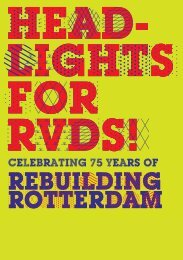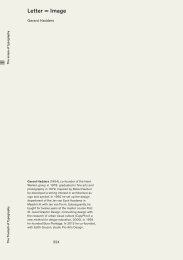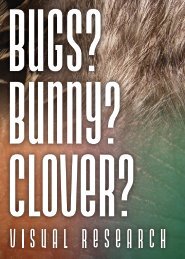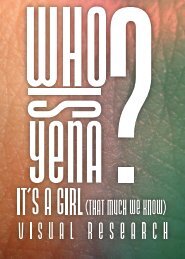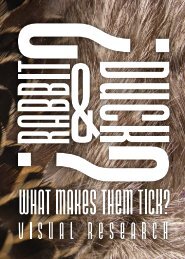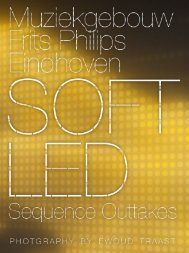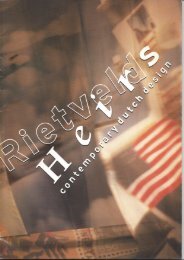Empfindungen
A collection of science imaging
A collection of science imaging
You also want an ePaper? Increase the reach of your titles
YUMPU automatically turns print PDFs into web optimized ePapers that Google loves.
1<br />
‘<strong>Empfindungen</strong>’<br />
Science Imaging<br />
HaddersGruson, januari 2019
2<br />
Enige citaten uit Wachelder, Kwa en Porco(?)<br />
‘De fotograaf P.H. Emerson (1856-1936) was gegrepen door het naturalisme. Zijn credo legde<br />
hij neer in een boek getiteld Naturalistic photography jör students of the art (1889). Daarin<br />
zette hij zich expliciet aftegen P.H. Robinson die in Pictorial effect in photography (1809) een<br />
methode voor het maken van kunstfoto’s uiteen had gezet. Robinson beval een techniek aan<br />
die neerkwam op het in één fotografisch beeld combineren van talloze (soms wel dertig)<br />
negatieven. Emerson daarentegen bepleitte een naturalistische fototechniek.4 Hij realiseerde<br />
zich echter dat het natuurgetrouw afbeelden van het object daarvoor niet langer volstond, maar<br />
dat de subjectieve ervaring van het kijken in de fotografische afbeelding verdisconteerd moest<br />
worden. Emerson maakte duidelijk dat om die reden naturalisme iets geheel anders was dan<br />
realisme.’<br />
‘By naturalism it will be seen that we mean a very different thing from realism. The realist<br />
makes no analysis, he is satisfied with the moats and leaves out the sunbeam. He<br />
will, in so far as he is able, paint all the veins on the leaves as they really are, and not as<br />
they look as a whole. For example, the realist, if painting a tree a hundred yards off,<br />
would not strive to render the tree as it appears to him from where he is sitting, but he 11<br />
would probably gather leaves off the tree and place them before him, and paint as they<br />
looked within twelve, inches of his eyes, and as the modern Pre-Raphaelites did, he<br />
might even imitate the local colour of the things themselves. Whereas the naturalist painter<br />
would care for none of these things, he would endeavour to render the impression<br />
of the tree as it appeared to him standing a hundred yards off, the tree taken as a<br />
whole, and as it looked, modified, as it would be by various phenomena and accidental<br />
circumstances”
3<br />
‘Maar Mach was ook gevoelig voor het theoretische probleem dat het naturalisme stelde. Mach<br />
worstelde met de ontologische consequenties van de recent verworven inzichten. Hij trok de<br />
conclusie dat het onderscheid tussen subject en. object niet langer ais vertrekpunt van reflectie kon<br />
fungeren. In plaats daarvan stelde hij voor van <strong>Empfindungen</strong> (met een been in de buitenwereld, en<br />
het andere in de waarnemer) uit te gaan. Terwijl het onderscheid tussen subject en object statisch,<br />
is, gaat het bij <strong>Empfindungen</strong> uit de aard der zaak om veranderingen in de tijd, om continuïteit.’<br />
“Microscopes and telescopes function as aids to vision in a way that neither the graphic<br />
nor the chronographic methods can. A scientist looking through a telescope sees lo or<br />
Ganymede and not pictures of them. In Marey’s procedures, the data are realized by the<br />
machinery in the form of visualizations - inscriptions, graphs, pictures. There is no<br />
moment during the operation of the instruments in which a scientist can take a peek 19<br />
at anything that might remotely approximate the results of the mechanical, data<br />
gathering operation.. In Marey’s program, the visualized data produced by the inscribing<br />
mechanisms have no existence apart from their realization” .<br />
‘Marey refers indifferently to the records produced by the methods as “curves”, “notations’”, and<br />
“tracings”, though he sometimes lapses into saying they “represent” certain kinds of movements.<br />
I do not want to be overly fastidious about the use of “represent”,but I do want to insist that these<br />
records, if they are to be thought of as representations, are not to be confused with pictures. If<br />
representation is a matter of re-presenting, it is difficult to imagine what the “re” might apply to in<br />
cases like the inscriptions produced on a sheet of paper by pressurized rubber balls glued to the<br />
hooves of an ambling horse”<br />
‘De eerste manier van kijken, ontstaan aan het einde van de achttiende eeuw, waardeert de<br />
natuurgetrouwheid (truth to nature). Een individu, bijvoorbeeld een vogel of een bloem, wordt<br />
op zo’n manier afgebeeld dat we alle individuen van dezelfde soort erin kunnen herkennen. De<br />
mechanische objectiviteit is de tweede manier: door gebruik te maken van fotografie of een<br />
andere mechanische methode delegeren we de waarneming aan de techniek. De feilbare mens
4<br />
zou daardoor – althans voor een heel stuk – uitgeschakeld moeten zijn. De derde manier van<br />
kijken, trained judgement, ontstond vrij snel na de vorige, rond 1900. Deze methode is juist weer<br />
optimistischer over het vermogen van de goed opgeleide onderzoeker om een correct oordeel te<br />
vellen over wat hij waarneemt.’<br />
‘De wil van Kant beleefde met de opkomst van het ideaal van het geoefende oordeel een<br />
soort eerherstel. De nieuwste loot aan de stam der beelden die volgens dit ideaal worden<br />
gemaakt, is die van de nanobuisjes en -draadjes. Deze beelden zijn geen ‘representatie van’, ze<br />
refereren niet aan iets wat in de natuur zou bestaan. Ze zijn het gereedschap van zelfbewuste<br />
technowetenschappers om vanuit de verbeelding te maken wat in de natuur zelf niet wordt<br />
aangetroffen.’<br />
‘The astronomical images we see on the web and in the media are usually ‘refined’ or<br />
‘processed’ as compared to the raw data that the astronomers work on with their computers. In<br />
‘pretty pictures’ all artefacts coming from the telescope or the detectors are for instance removed<br />
as they do not say anything about the objects themselves. It is very rare that images are taken<br />
with the sole intention of producing a ‘pretty’ colour picture. Most ‘pretty pictures’ are constructed<br />
from data that was acquired to study some physical process, and the astronomer herself probably<br />
never bothered to assemble the greyscale images to a colour image.’<br />
‘When processing raw science images one of the biggest problems is that, to a large degree, you<br />
are ‘creating’ the image and this means a colossal freedom within a huge parameter space. There<br />
are literally thousands of sliders, numbers, dials, curves etc. to twist and turn.<br />
Speaking of right and wrong, there really are no wrong or right images. There are some<br />
fundamental scientific principles that should normally be observed, but the rest is a matter<br />
of aesthetics — taste. Chromatic ordering of the exposures is one of the important scientific<br />
principles.’
5
6<br />
Deze verkenning is tot stand gekomen op basis van de zoektermen:<br />
- Astronomie<br />
- Deeltjesfysica<br />
- Nanotechnologie<br />
- Neurologie<br />
- Celbiologie<br />
- Genetica<br />
- Kankeronderzoek<br />
De beelden en filmpjes zijn op basis van bestandgrootte geplaatst; de<br />
kleine aan het begin, de grootste op het eind en hier is maar sporadisch<br />
de hand mee gelicht als het resultaat te veel ‘dubbelde’. De hierdoor<br />
onstane ‘paren’ zijn dus volstrekt toevallig tot stand gekomen met<br />
vaak een verassend resultaat. Hieruit valt - ondermeer - te leren dat<br />
wetenschappelijk beeld vaak meer begint te ‘spreken’ in samenhang<br />
met een andere ‘taal’.<br />
Ook de grote hoeveelheid van beelden hierin opgenomen is belangrijk.<br />
Indachtig de ‘willoosheid’ die wetenschappers aangeraden werd<br />
te hanteren om de ware objectivistische blik te ontwikkelen, moet<br />
men zich onderdompelen in beeld, onderwerp en techniek om een<br />
‘inclusieve blik’ te verwerven. In plaats van een ‘exclusieve blik’, een<br />
manier van kijken die bij voorbaat al bepaalde beelden zal uitsluiten.<br />
Verder heb ik gemeend een gering aantal kunstwerken - overigens ook<br />
via toeval - te plaatsen in de beeldenreeks. Niet vanuit de misvatting<br />
dat Wetenschappelijk Beeld kunst zou zijn, maar vanuit de vaststelling<br />
dat veel kunstenaars over een ‘wetenschappelijke blik’ beschikken.<br />
Er is een lichte printversie en een zwaardere interactieve versie waarin<br />
± 110 filmpjes afgespeeld kunnen worden. De filmpjes zij allen 3 tot 5<br />
maal vertraagd om de opbouw beter te kunnen zien.<br />
Gerard Hadders, 30 januari 2019
7
8
9
10
11
12
13
14
15
16
17
18
19
20
21
22
23
24
25
26
27
28
29
30
31
32
33
34
35
36
37
38
39
40
41
42
43
44
45
46
47
48
49
50
51
52
53
54
55
56
57
58
59
60
61
62
63
64
65
66
67
68
69
70
71
72
73
74
75
76
77
78
79
80
81
82
83
84
85
86
87
88
89
90
91
92
93
94
95
96
97
98
99
100
101
102
103
104
105
106
107
108
109
110
111
112
113
114
115
116
117
118
119
120
121
122
123
124
125
126
127
128
129
130
131
132
133
134
135
136
137
138
139
140
141
142
143
144
145
146
147
148
149
150
151
152
153
154
155
156
157
158
159
160
161
162
163
164
165
166
167
168
169
170
171
172
173
174
175
176
177
178
179
180
181
182
183
184
185
186
187
188
189
190
191
192
193
194
195
196
197
198
199
200
201
202
203
204
205
206
207
208
209
210
211
212
213
214
215
216
217
218
219
220
221
222
223
224
225
226
227
228
229
230
231
232
233
234
235
236
237
238
239
240
241
242
243
244
245
246
247
248
249
250
251
252
253
254
255
256
257
258
259
260
261
262
263
264
265
266
267
268
269
270
271
272
273
274
275
276
277
278
279
280
281
282
283
284
285
286
287
288
289
290
291
292
293
294
295
296
297
298
299
300
301
302
303
304
305
306
307
308
309
310
311
312
313
314
315
316
317
318
319
320
321
322
323
324
325
326
327
328
329
330
331
332
333
334
335
336
337
338
339
340
341
342
343
344
345
346
347
348
349
350
351
352
353
354
355
356
357
358
359
360
361
362
363
364
365
366
367
368
369
370
371
372
373
374
375
376
377
378
379
380
381
382
383
384
385
386
387
388
389
390
391
392
393
394
395
396
397
398
399
400
401
402
403
404<br />
‘<strong>Empfindungen</strong>’<br />
SMB_TB2_Survey_print<br />
HaddersGruson, januari 2019


